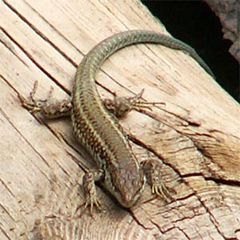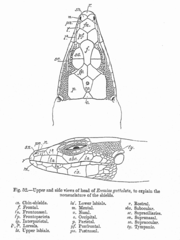| Lacertidae | ||||||||||||
|---|---|---|---|---|---|---|---|---|---|---|---|---|

Podarcis hispanica
|
||||||||||||
| Scientific classification | ||||||||||||
|
||||||||||||
Many, see text.
Terminology and scalation of lacertids
|
Lacertidae is the family of the wall lizards, which are native to Europe, Africa, and Asia, and (in Lacerta) include some of the most common types seen in Europe.
Contents |
Habitat
All species are terrestrial. European and Mediterranean species live mainly in forest and scrub habitats. Eastward Eremias and Ophisops replace them in the grassland and desert habitats of Asia. African species usually live in rocky, arid areas. Holaspis is one of the few arboreal lacertids, and its single species (Holaspis guentheri) is a glider, although apparently a poor one using its broad tail and flattened body as an aerofoil (Zug et al. 2001).
Size
Small or medium-sized; usually less than 9 cm snout-vent length, but a few species exceed 15 cm SVL (Lacerta lepida).
Food
Primarily insectivorous. Meroles anchietae (formerly Aporosaura anchietae) is one of the few Wall lizards that regularly eats seeds, not an unlikely food for a lizard of the harsh Namib Desert.
Reproduction
At least 8 species of Lacerta are parthenogenetic and all are oviparous except for some populations of Lacerta vivipara.
Identification
The Common Wall Lizard is a small, thin lizard whose small scales are highly variable in color and pattern. Their coloration is generally brownish or grayish, and may occasionally be tinged with green. In some individuals the row of spots along their back may form a line, while others may have a reticulated pattern with dark spots on the side and scattered white spots that can be blue in the shoulder region. The tail is brown, grey or rust in color, and may also have light bars on the sides. The belly region has 6 rows of larger rectangular scales that are generally reddish, pink, or orangish. Common Wall Lizards may also have dark markings on the throat.
Distribution and Status
The Common Wall Lizard is an introduced species whose natural range spans mainland Europe in central Spain, southern Belgium, and the Netherlands. In the US this lizard has established populations along the Ohio River and within Cincinnati, Ohio, particularly in the vicinity of the Cincinnati Zoo (US distribution map). Within the Midwest/Upper South, the Common Wall Lizard is only found in Ohio and Northern Kentucky.
Ecology
The Common Wall Lizard prefers urban settings where it can scurry between rock, rubble, debris and buildings.
Classification
Family Lacertidae
- Subfamily Gallotiinae
- Genus Gallotia
Genus Psammodromus
- Genus Gallotia
- Subfamily Lacertinae
- Genus Acanthodactylus
Genus Adolfus
Genus Algyroides
Genus Australolacerta
Genus Darevskia
Genus Eremias
Genus Gastropholis
Genus Holaspis
Genus Heliobolus
Genus Iberolacerta
Genus Ichnotropis
Genus Lacerta
Genus Latastia
Genus Meroles
Genus Mesalina
Genus Nucras
Genus Ophisops
Genus Pedioplanis
Genus Philochortus
Genus Podarcis
Genus Poromera
Genus Pseuderemias
Genus Takydromus
Genus Timon
Genus Tropidosaura
- Genus Acanthodactylus